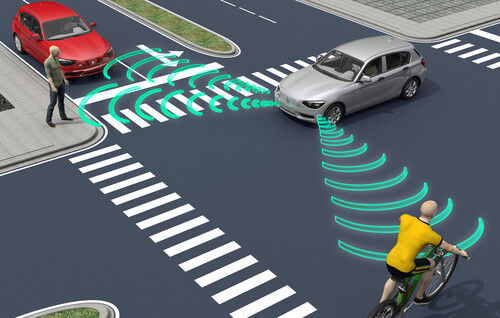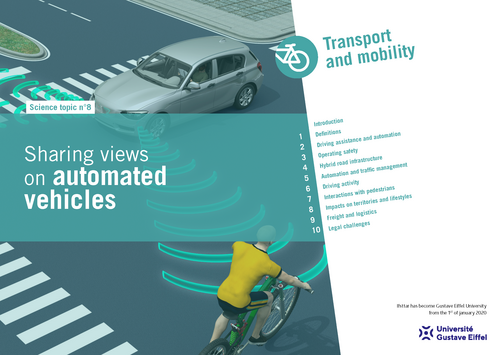Sharing views on automated vehicle
Abdelmename Hedhli, Scientific coordinator of the science topic, Université Gustave Eiffel
New information and communication technologies have now become part of our daily lives as examplifi ed in the fi eld of transportation. Intelligent transportation systems (ITS) thus provide new solutions to remedy the consequences of the massive use of certain mobility modes. They offer a wide scope of application (road safety, traffi c management, multimodal information, ticketing, driving assistance, etc.) and involve a large spectrum of technologies among which those related to the development of self-driving and connected vehicles.
A complex and cross-disciplinary topic
Often presented as a major technological break-through, self-driving vehicles hold the promise of far-reaching transformations for our societies. Their adoption by users will depend on how the four key fundamentals are taken into consideration: improving road safety, optimising infrastructure capacity, mitigating impacts on the environment and facilitating mobility for all. To address these overarching challenges, Ifsttar has for many years made this topic of autono-mous vehicles a priority field of research. It has done so in a cross-disciplinary and systemic approach in order to address this complex topic which entails diverse technological, human, legal and societal issues dimensions.
A vehicle that is autonomous but also one that is connected
Whereas the self-driving vehicle is conceptually presented as a mobile robot, the connected vehicle refers to the capability to communicate and share information. Whether it is between vehicles, or between the road infrastructure and the com-munication infrastructure, these exchanges allow improving the safety and comfort of users as well as the management of infrastructures. Gustave Eiffel Université, with projects such as SCOOP@F, is very much involved in this area.
Although at the present time the research approach and concepts on which self-driving and connected vehicles are based are different, the two will soon become complementary. Indeed, in order to enhance its environment perception capacities, overcome the problems found on a given itinerary and improve safety, the autonomous vehicle will have to be connected to the infrastructure and to the other vehicles.
And what about the human driver?
Before these vehicles can be commercially available, i.e. in 2020 according to several French auto-makers, a number of obstacles and technological, regulatory, legal and social hurdles remain to be cleared, in which the human component plays a paramount role. It is also important to bear in mind that the development of autono-mous vehicles will be a gradual process and thus entail a transition phase during which roads will be shared by vehicles with and without drivers. In addition, human intervention will remain necessary for as long as vehicle automation is only partial (for instance, level 3 refers to phases where the human driver is requested to resume control).
Often presented as a major technological innovation, the autonomous vehicle can potentially lead to significant transformations for our societies.

Credits : Epictura
Summary
Introduction
What is an autonomous vehicle?
- By Sébastien Glaser
From driving assistance systems to vehicle automation
Operating dependability and safety of autonomous vehicles
Toward a hybrid road infrastructure
Impacts of connected and automated vehicles on traffic, safety and pollutant emissions
Impacts of automation on the driving activity
Anticipate on the interactions between pedestrians and self-driving vehicles
Impacts of self-driving vehicle on territories and lifestyles
An opportunity for freight and logistics?
Legal challenges for connected and autonomous vehicles
Identity card of the science topic
| Title: | Sharing views on automated vehicles |
| Coordinator: | Abdelmename Hedhli |
| Authors: | Abdelmename Hedli, Sébastien Glaser, Dominique Gruyer, El Miloudi El Koursi, Nicolas Hautière, Nour-Eddin El Faouzi, Hélène Tattegrain, Aurélie Dommes, Jean-Michel Auberlet, Olivier Bonin, François Combes |
| Collection: | Ifsttar sciences topics |
| Version: | PDF for free download in web and print versions |
| Licence: | Creative Common CC BY-SA 4.0 |
| Publication: | June 2017 |
| Languages: | French and english |
| Keywords: | Driving, autonomous vehicle, innovation, safety, automation, Ifsttar science topics |

